Radon Anomalies and Earthquake Prediction: Trends and Research Hotspots in the Scientific Literature
Abstract
1. Introduction
2. Methodology
2.1. Study Design
2.2. Database Search Strategy
- Group 1: Radon(“radon anomaly” OR “radon anomalies” OR “radon concentration” OR “radon gas” OR “radon emission” OR “radon exhalation” OR “soil gas radon” OR “Rn-222”);
- Group 2: Seismicity(“earthquake” OR “earthquakes” OR “seismic activity” OR “seismic event” OR “seismic events” OR “seismic precursor” OR “precursory signal”);
- Group 3: Analytical focus(“correlation” OR “correlations” OR “predictive value” OR “prediction” OR “forecasting” OR “forecast” OR “statistical analysis” OR “data analysis”).
- Exclusion group: Mathematical focus(“Radon transform” OR “Radon integral” OR “Radon mathematical”).
2.3. Eligibility Criteria and Screening Procedure
- Inclusion criteria:
- –
- Articles published in peer-reviewed journals.
- –
- Documents written exclusively in English.
- –
- Availability of complete metadata in the Scopus or Web of Science databases.
- Exclusion criteria:
- –
- Duplicate records across both databases.
- –
- Documents written in languages other than English.
- –
- Documents such as review articles, conference proceedings, book chapters, etc.
- In the identification phase, 726 records were retrieved, 391 of which came from Scopus and 335 from the Web of Science. Subsequently, 229 duplicate records were removed, resulting in 497 unique records.
- During the screening phase, the titles and abstracts of these records were examined. At this stage, 31 documents were excluded due to language criteria, as they were written in languages other than English: 20 in Chinese, 3 in Russian, 2 in Japanese, and 6 in other languages.
- It is important to note that no documents were classified as “not retrieved” (reports not retrieved = 0). The bibliometric approach adopted in this study based the analysis exclusively on the metadata exported from the selected databases. Therefore, it was not necessary to access the full texts of the articles, as no detailed content assessment was performed. Consequently, 466 records were retained for further evaluation.
- In the eligibility assessment phase, 87 documents were excluded for not meeting the predefined inclusion criteria. These documents were categorized as follows: 61 conference proceedings, 18 review articles, 6 book chapters, 2 documents classified as “other”.
2.4. Semantic Cleaning of the Dataset
- Generic methodological or structural terms: article, parameters, field, samples, time, exposure, analysis, identification, monitoring, forecasting, prediction, model, mechanism, system, systems, modelling, carrier, level, phenomena;
- Generic geographical, topographical, or spatial terms: area, region, zone, location, valley, surface, fault, faults, crust, rock, soil, spring, waters, thermal springs, volcano, eruption;
- Overly broad or transversal physical or environmental variables: temperature, pressure, flow, transport, water, gas, air, groundwater, stress, deformation, evolution, permeability, magnitude, hazard, atmosphere, abnormal;
- Duplicate concepts or high-frequency terms lacking discriminative value: radon, earthquake, earth quake, earthquakes, precursor, precursors, variation, variations.
2.5. Bibliometric Analysis
3. Results
3.1. Scientific Production and Temporal Evolution
3.2. Geographical Distribution and International Collaboration
3.2.1. Production by Countries
3.2.2. Corresponding Author Countries
3.2.3. Country Collaboration Network
3.2.4. Most Relevant Affiliation
3.3. Most Influential Sources and Articles
3.3.1. Most Relevant Sources
3.3.2. Most Relevant Articles
3.4. Research Topics and Thematic Evolution
3.4.1. Word Cloud of Author Keywords
3.4.2. Co-Occurrence of Author Keywords
3.4.3. General Thematic Map
3.4.4. Last Decade Thematic Map (2014–2025)
4. Discussion
4.1. Main Findings
4.2. Comparison with Previous Reviews
5. Limitations
6. Future Perspectives
7. Conclusions
Supplementary Materials
Author Contributions
Funding
Conflicts of Interest
References
- Ghosh, D.; Deb, A.; Sengupta, R.; Nath, B.; Saha, D.; Ghosh, B.; Mukherjee, A.; Ghosh, R. Anomalous radon emission as precursor of earthquakes: A case study in West Bengal, India. Bull. Earthq. Eng. 2020, 18, 6113–6129. [Google Scholar] [CrossRef]
- Bansal, B.K.; Verma, M.; Gupta, A.K.; Prasath, R.A. On mitigation of earthquake and landslide hazards in the eastern Himalayan region. Nat. Hazards 2022, 114, 1079–1102. [Google Scholar] [CrossRef] [PubMed]
- Bommer, J.J.; Crowley, H.; Pinho, R. A risk-mitigation approach to the management of induced seismicity. J. Seismol. 2015, 19, 623–646. [Google Scholar] [CrossRef]
- Xie, Y. Deep Learning in Earthquake Engineering: A Comprehensive Review. arXiv 2024, arXiv:2405.09021. [Google Scholar] [CrossRef]
- Crampin, S.; Evans, R.; Atkinson, B.K. Earthquake prediction: A new physical basis. Geophys. J. Int. 1984, 76, 147–156. [Google Scholar] [CrossRef]
- Kanamori, H.; Anderson, D.L. Theoretical basis of some empirical relations in seismology. Bull. Seismol. Soc. Am. 1975, 65, 1073–1095. [Google Scholar]
- Shehadeh, K.S.; Tucker, E.L. Stochastic optimization models for location and inventory prepositioning of disaster relief supplies. Transp. Res. Part C Emerg. Technol. 2022, 144, 103871. [Google Scholar] [CrossRef]
- Oh, Y.H.; Kim, G. A radon-thoron isotope pair as a reliable earthquake precursor. Sci. Rep. 2015, 5, 13084. [Google Scholar] [CrossRef]
- Quindós Poncela, L.S.; Sainz Fernández, C.; Fuente Merino, I.; Fernández Navarro, P.; Nicolás Mangas, J. The use of radon as tracer in environmental sciences. Acta Geophys. 2013, 61, 848–858. [Google Scholar] [CrossRef]
- Elío, J.; Ortega, M.F.; Nisi, B.; Mazadiego, L.F.; Vaselli, O.; Caballero, J.; Quindós-Poncela, L.S.; Sainz-Fernández, C.; Pous, J. Evaluation of the applicability of four different radon measurement techniques for monitoring CO2 storage sites. Int. J. Greenh. Gas Control. 2015, 41, 1–10. [Google Scholar] [CrossRef]
- Petraki, E.; Nikolopoulos, D.; Panagiotaras, D.; Cantzos, D.; Yannakopoulos, P.; Nomicos, C.; Stonham, J. Radon-222: A potential short-term earthquake precursor. J. Earth Sci. Clim. Chang. 2015, 6, 282. [Google Scholar] [CrossRef]
- Hua, Q. Radiocarbon: A chronological tool for the recent past. Quat. Geochronol. 2009, 4, 378–390. [Google Scholar] [CrossRef]
- Chen, C.; Thomas, D.M. Analysis of volatile-phase transport in soils using natural radon gas as a tracer. J. Environ. Qual. 1994, 23, 173–179. [Google Scholar] [CrossRef]
- Huxol, S.; Brennwald, M.S.; Hoehn, E.; Kipfer, R. On the fate of 220Rn in soil material in dependence of water content: Implications from field and laboratory experiments. Chem. Geol. 2012, 298–299, 116–122. [Google Scholar] [CrossRef]
- Imm, G.; Morelli, D. Radon as earthquake precursor. In Earthquake Research and Analysis: Statistical Studies, Observations and Planning; D’Amico, S., Ed.; InTech: Rijeka, Croatia, 2012. [Google Scholar] [CrossRef]
- Pulinets, S.; Herrera, V.M.V. Earthquake Precursors: The Physics, Identification, and Application. Geosciences 2024, 14, 209. [Google Scholar] [CrossRef]
- Fu, C.C.; Yang, T.F.; Tsai, M.C.; Lee, L.C.; Liu, T.K.; Walia, V.; Chen, C.H.; Chang, W.Y.; Kumar, A.; Lai, T.H. Exploring the relationship between soil degassing and seismic activity by continuous radon monitoring in the Longitudinal Valley of eastern Taiwan. Chem. Geol. 2017, 469, 163–175. [Google Scholar] [CrossRef]
- Alam, A.; Wang, N.; Zhao, G.; Barkat, A. Implication of radon monitoring for earthquake surveillance using statistical techniques: A case study of Wenchuan earthquake. Geofluids 2020, 2020, 2429165. [Google Scholar] [CrossRef]
- Zhou, H.; Su, H.; Zhang, H.; Li, C.; Ma, D.; Bai, R. Geochemical characteristics of soil gas and strong seismic hazard potential in the Liupanshan Fault Zone (LPSFZ). Geofluids 2020, 2020, 4917924. [Google Scholar] [CrossRef]
- Riggio, A.; Santulin, M. Earthquake forecasting: A review of radon as seismic precursor. Boll. Geofis. Teor. Appl. 2015, 56, 95–114. [Google Scholar] [CrossRef]
- Planinić, J.; Radolić, V.; Vuković, B. Radon as an earthquake precursor. Nucl. Instruments Methods Phys. Res. Sect. A Accel. Spectrometers Detect. Assoc. Equip. 2004, 530, 568–574. [Google Scholar] [CrossRef]
- Walia, V.; Virk, H.S.; Yang, T.F.; Mahajan, S.; Walia, M.; Bajwa, B.S. Earthquake prediction studies using radon as a precursor in N-W Himalayas, India: A case study. TAO Terr. Atmos. Ocean. Sci. 2005, 16, 775–804. [Google Scholar] [CrossRef]
- Bujacz, A. Structures of bovine, equine and leporine serum albumin. Biochim. Biophys. Acta (BBA)—Proteins Proteom. 2009, 1794, 1305–1310. [Google Scholar] [CrossRef]
- Zmazek, B.; Todorovski, L.; Džeroski, S.; Vaupotič, J.; Kobal, I. Application of decision trees to the analysis of soil radon data for earthquake prediction. Appl. Radiat. Isot. 2003, 58, 697–706. [Google Scholar] [CrossRef]
- Woith, H. Radon earthquake precursor: A short review. Eur. Phys. J. Spec. Top. 2015, 224, 611–627. [Google Scholar] [CrossRef]
- Stoulos, S.; Papadimitriou, E.; Karakostas, V.; Kourouklas, C.; Atac-Nyberg, A.; Wyss, R.; Bäck, T.; Tallini, M.; DeLuca, G. Radon signals in soil gas associated with earthquake occurrence in Greece: Review and perspective. J. Radioanal. Nucl. Chem. 2024, 333, 6107–6120. [Google Scholar] [CrossRef]
- Conti, L.; Picozza, P.; Sotgiu, A. A Critical Review of Ground-Based Observations of Earthquake Precursors. Front. Earth Sci. 2021, 9, 676766. [Google Scholar] [CrossRef]
- Morales-Simfors, N.; Wyss, R.A.; Bundschuh, J. Recent progress in radon-based monitoring as seismic and volcanic precursor: A critical review. Crit. Rev. Environ. Sci. Technol. 2019, 50, 979–1012. [Google Scholar] [CrossRef]
- Huang, P.; Lv, W.; Huang, R.; Luo, Q.; Yang, Y. Earthquake precursors: A review of key factors influencing radon concentration. J. Environ. Radioact. 2024, 271, 107310. [Google Scholar] [CrossRef] [PubMed]
- Ghosh, D.; Deb, A.; Sengupta, R. Anomalous radon emission as precursor of earthquake. J. Appl. Geophys. 2009, 69, 67–81. [Google Scholar] [CrossRef]
- Aria, M.; Cuccurullo, C. bibliometrix: An R-tool for comprehensive science mapping analysis. J. Inf. 2017, 11, 959–975. [Google Scholar] [CrossRef]
- Page, M.J.; McKenzie, J.E.; Bossuyt, P.M.; Boutron, I.; Hoffmann, T.C.; Mulrow, C.D.; Shamseer, L.; Tetzlaff, J.M.; Akl, E.A.; Brennan, S.E.; et al. The PRISMA 2020 statement: An updated guideline for reporting systematic reviews. BMJ 2021, 372, n71. [Google Scholar] [CrossRef]
- Jordan, T.H.; Chen, Y.-T.; Gasparini, P.; Madariaga, R.; Main, I.; Marzocchi, W.; Papadopoulos, G.; Sobolev, G.; Yamaoka, K.; Zschau, J. Operational earthquake forecasting: State of knowledge and guidelines for utilization. Ann. Geophys. 2011, 54, 315–391. [Google Scholar] [CrossRef]
- King, C.-Y. Episodic radon changes in subsurface soil gas along active faults and possible relation to earthquakes. J. Geophys. Res. Solid Earth 1980, 85, 3065–3078. [Google Scholar] [CrossRef]
- Baubron, J.-C.; Rigo, A.; Toutain, J.-P. Soil gas profiles as a tool to characterise active tectonic areas: The Jaut Pass example (Pyrenees, France). Earth Planet. Sci. Lett. 2002, 196, 69–81. [Google Scholar] [CrossRef]
- Ciotoli, G.; Lombardi, S.; Annunziatellis, A. Geostatistical analysis of soil gas data in a high seismic intermontane basin: Fucino Plain, central Italy. J. Geophys. Res. Solid Earth 2007, 112, B05407. [Google Scholar] [CrossRef]
- Wakita, H.; Nakamura, Y.; Sano, Y. Short-term and intermediate-term geochemical precursors. Pure Appl. Geophys. 1988, 126, 267–278. [Google Scholar] [CrossRef]
- Virk, H.S.; Singh, B. Radon recording of Uttarkashi earthquake. Geophys. Res. Lett. 1994, 21, 737–740. [Google Scholar] [CrossRef]
- Rikitake, T. Earthquake precursors in Japan: Precursor time and detectability. Tectonophysics 1987, 136, 265–282. [Google Scholar] [CrossRef]
- Etiope, G.; Martinelli, G. Migration of Carrier and Trace Gases in the Geosphere: An Overview. Phys. Earth Planet. Inter. 2002, 129, 185–204. [Google Scholar] [CrossRef]
- Scholz, C.H.; Sykes, L.R.; Aggarwal, Y.P. Earthquake Prediction: A Physical Basis. Science 1973, 181, 803–810. [Google Scholar] [CrossRef] [PubMed]
- Singh, S.; Jaishi, H.P.; Tiwari, R.P.; Tiwari, R.C. Time Series Analysis of Soil Radon Data Using Multiple Linear Regression and Artificial Neural Network in Seismic Precursory Studies. Pure Appl. Geophys. 2017, 174, 2793–2802. [Google Scholar] [CrossRef]
- Jena, R.; Pradhan, B.; Naik, S.P.; Alamri, A.M. Earthquake risk assessment in NE India using deep learning and geospatial analysis. Geosci. Front. 2021, 12, 101110. [Google Scholar] [CrossRef]
- Daneshvar, M.R.M.; Freund, F.T. Remote sensing of atmospheric and ionospheric signals prior to the Mw 8.3 Illapel earthquake, Chile 2015. Pure Appl. Geophys. 2017, 174, 11–45. [Google Scholar] [CrossRef]
- Manea, V.C.; Manea, M.; Ferrari, L.; Orozco, T.; Valenzuela, R.W.; Husker, A.; Kostoglodov, V. A review of the geodynamic evolution of flat slab subduction in Mexico, Peru, and Chile. Tectonophysics 2017, 695, 27–52. [Google Scholar] [CrossRef]
- Guo, J.; Li, W.; Yu, H.; Liu, Z.; Zhao, C.; Kong, Q. Impending ionospheric anomaly preceding the Iquique Mw8.2 earthquake in Chile on 2014 April 1. Geophys. J. Int. 2015, 203, 1461–1470. [Google Scholar] [CrossRef]
- Nikolopoulos, D.; Cantzos, D.; Alam, A.; Dimopoulos, S.; Petraki, E. Electromagnetic and Radon Earthquake Precursors. Geosciences 2024, 14, 271. [Google Scholar] [CrossRef]
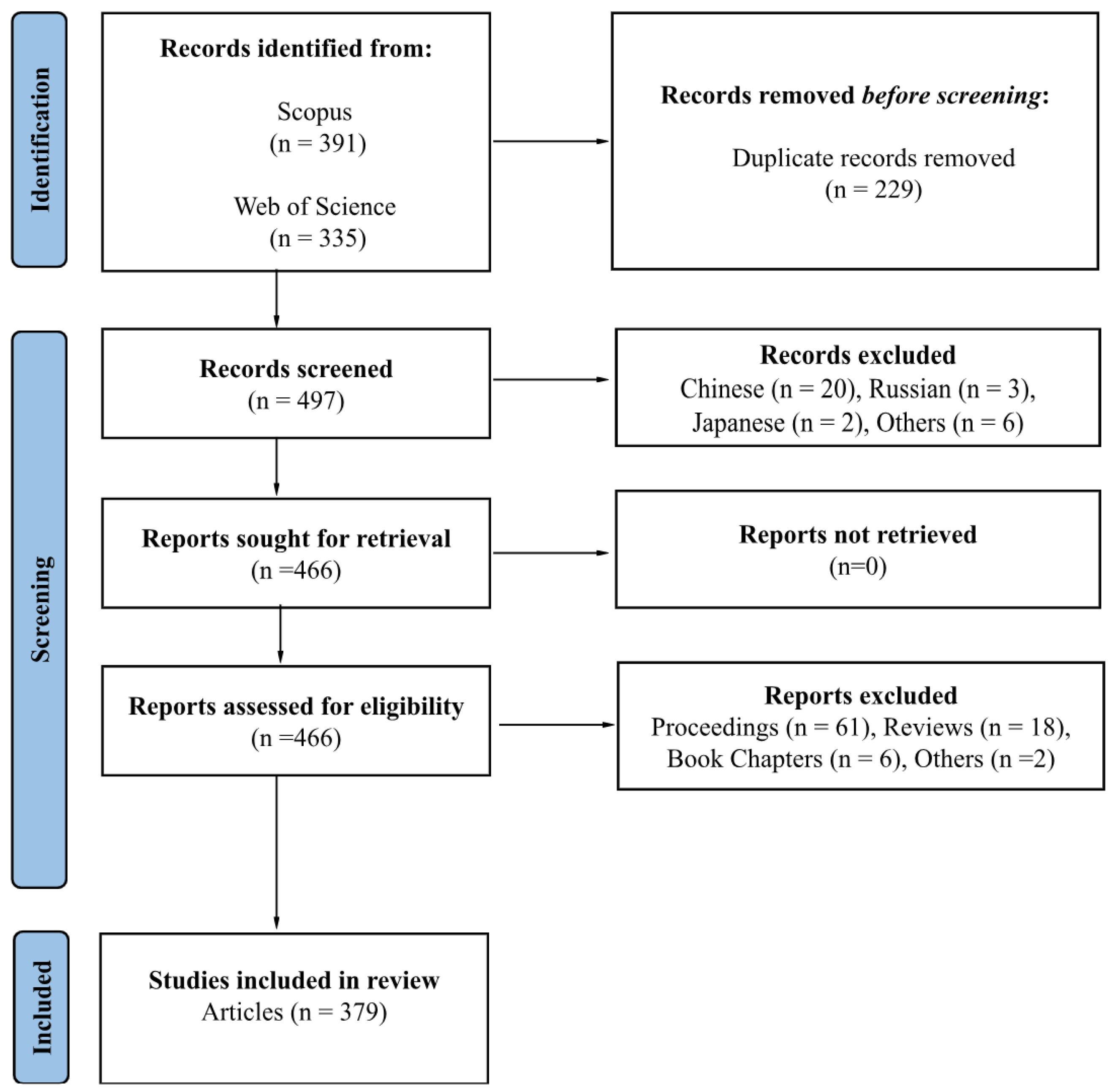
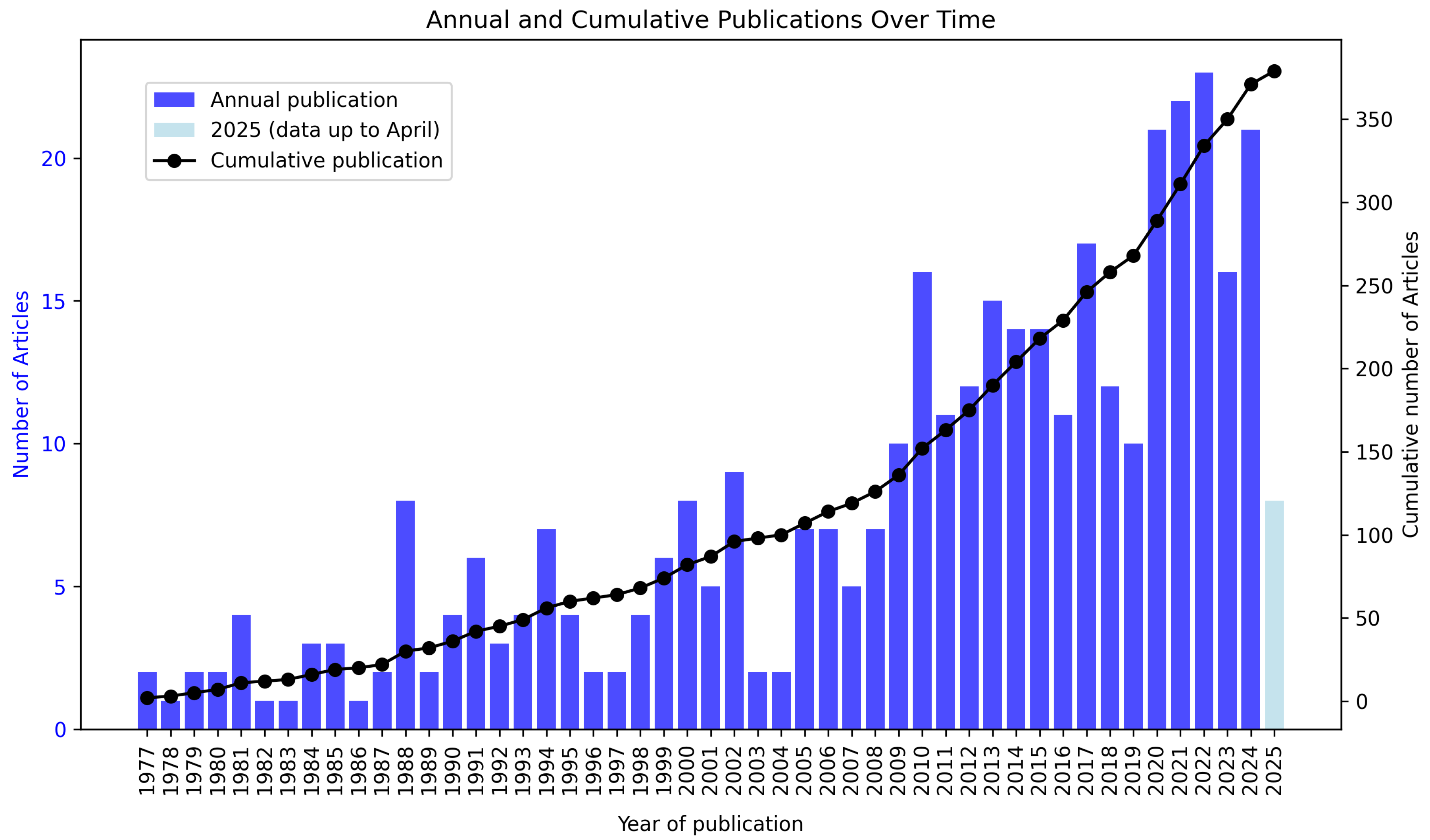
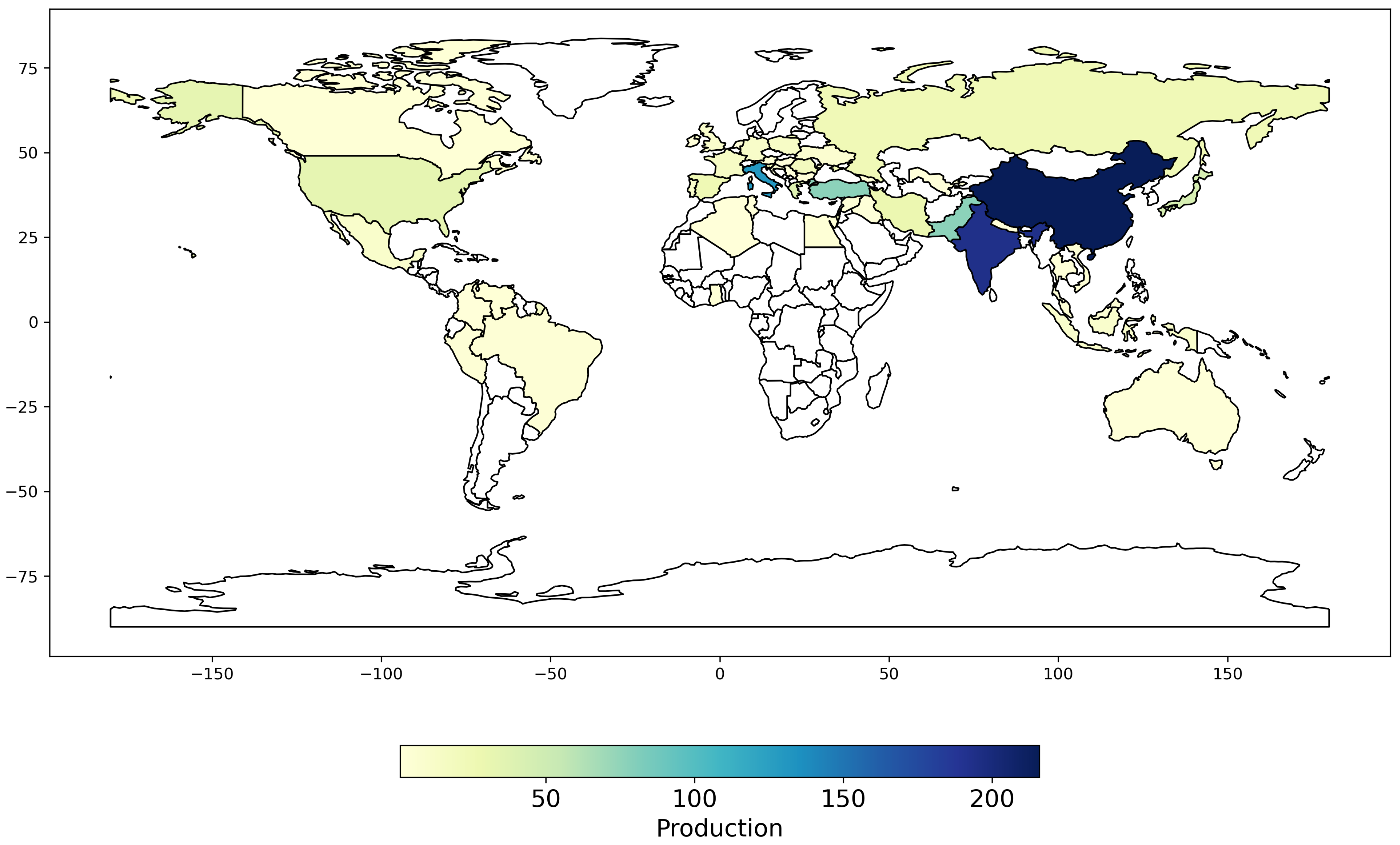

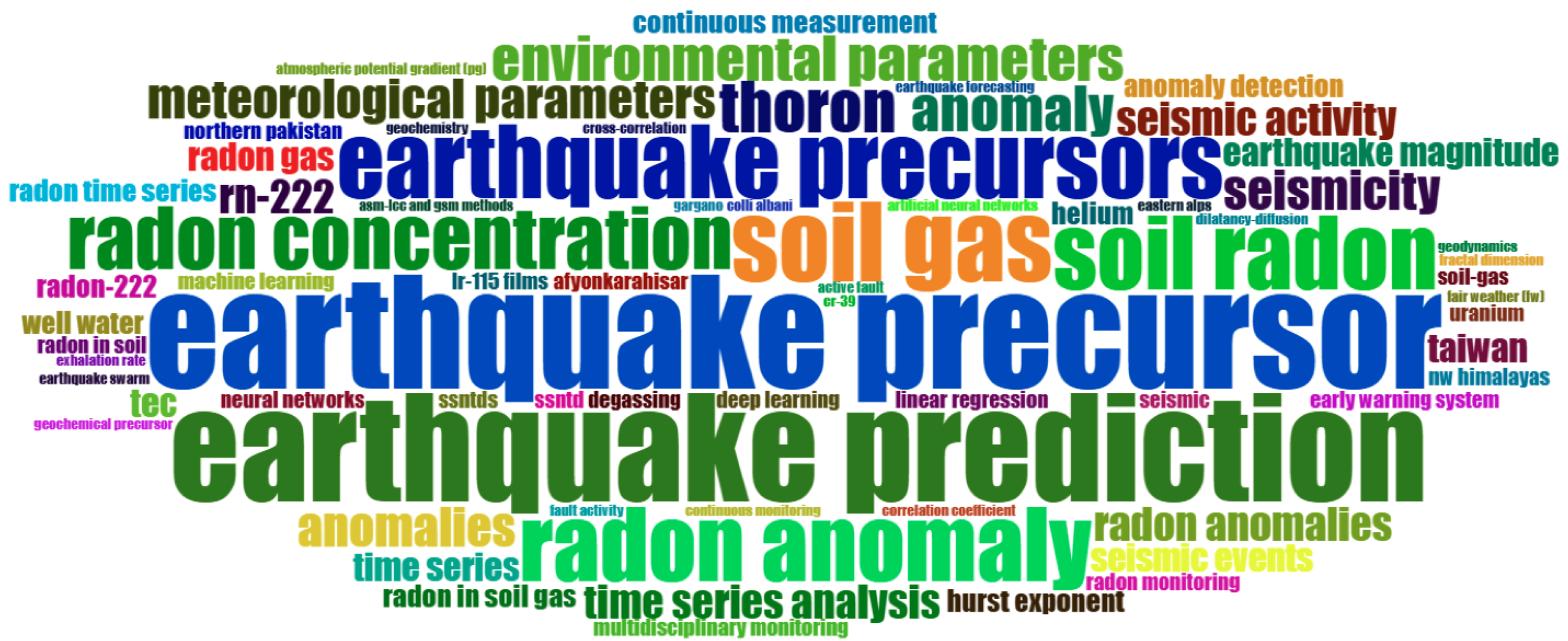
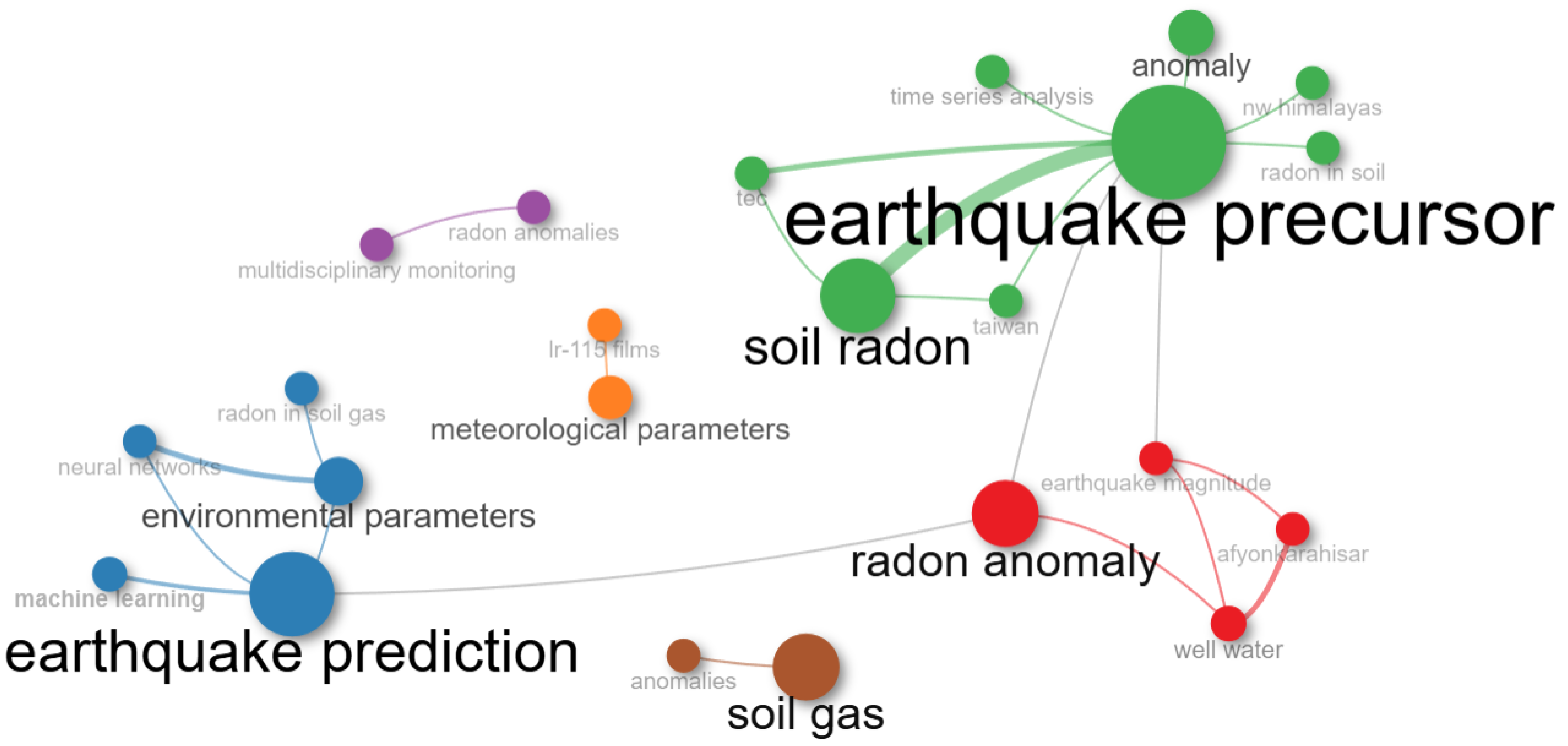
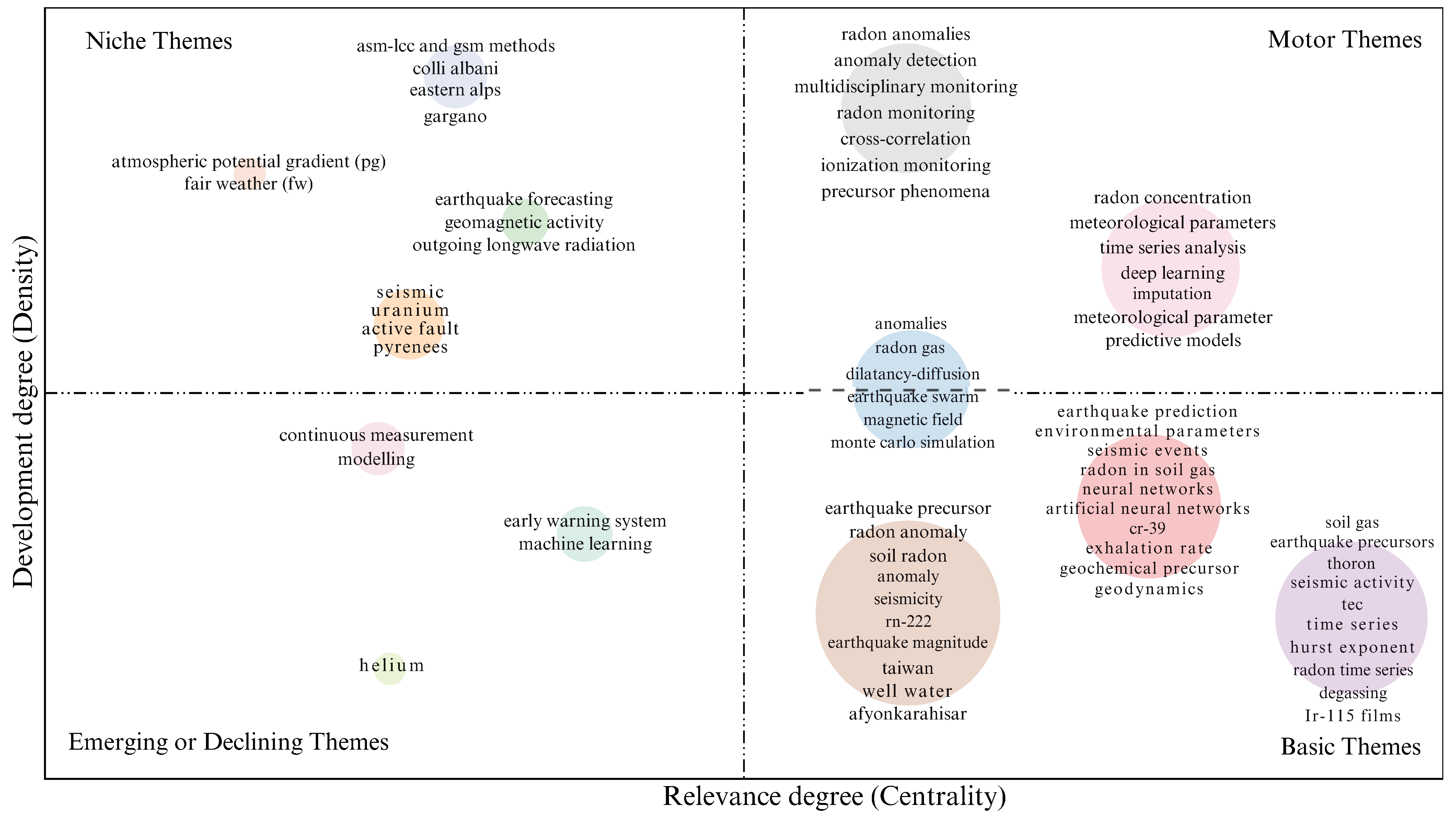
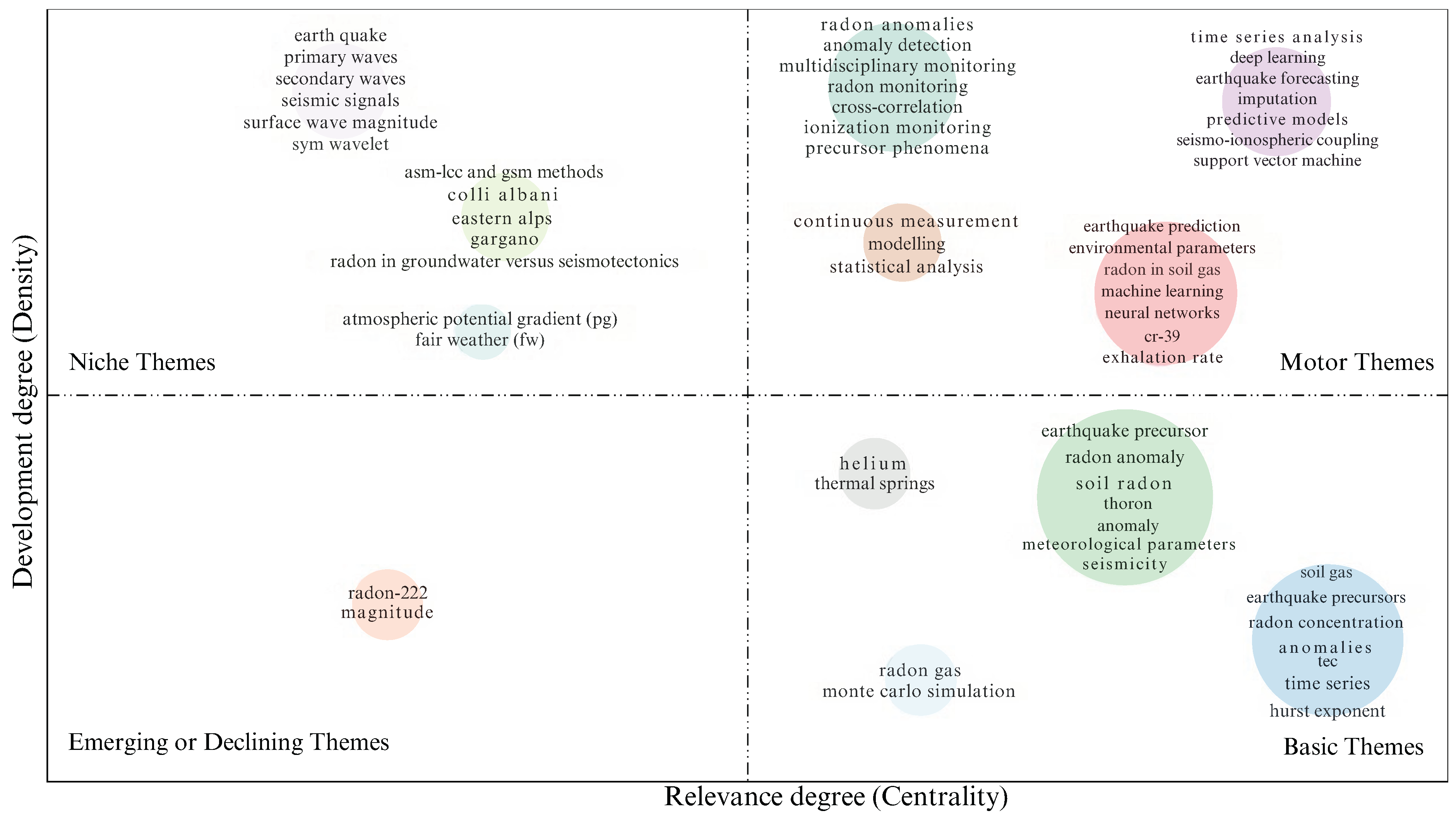
| Country | Publications | Publications (%) | SCP | SCP (%) | MCP | MCP (%) |
|---|---|---|---|---|---|---|
| India | 67 | 17.7 % | 63 | 94.0 % | 4 | 6.0 % |
| China | 49 | 12.9 % | 37 | 75.5 % | 12 | 24.5 % |
| Italy | 39 | 10.3 % | 34 | 87.2 % | 5 | 12.8 % |
| Turkey | 24 | 6.3 % | 20 | 83.3 % | 4 | 16.7 % |
| Pakistan | 18 | 4.7 % | 8 | 44.4 % | 10 | 55.6 % |
| Japan | 10 | 2.6 % | 9 | 90.0 % | 1 | 10.0 % |
| Greece | 9 | 2.4 % | 5 | 55.6 % | 4 | 44.4 % |
| Slovenia | 9 | 2.4 % | 7 | 77.8 % | 2 | 22.2 % |
| Iran | 8 | 2.1 % | 8 | 100.0 % | 0 | 0 % |
| Russia | 8 | 2.1 % | 6 | 75.0 % | 2 | 25.0 % |
| Korea | 7 | 1.8 % | 6 | 85.7 % | 1 | 14.3 % |
| Romania | 7 | 1.8 % | 7 | 100.0 % | 0 | 0 % |
| Spain | 7 | 1.8 % | 7 | 100.0 % | 0 | 0 % |
| Indonesia | 5 | 1.3 % | 5 | 100.0 % | 0 | 0 % |
| United States | 5 | 1.3 % | 2 | 40.0 % | 3 | 60.0 % |
| Germany | 4 | 1.1 % | 3 | 75.0 % | 1 | 25.0 % |
| Israel | 4 | 1.1 % | 3 | 75.0 % | 1 | 25.0 % |
| Poland | 4 | 1.1 % | 3 | 75.0 % | 1 | 25.0 % |
| Croatia | 3 | 0.8 % | 3 | 100.0 % | 0 | 0 % |
| France | 3 | 0.8 % | 2 | 66.7 % | 1 | 33.3 % |
| Mexico | 3 | 0.8 % | 3 | 100.0 % | 0 | 0 % |
| Affiliations (Country) | Articles/Affiliation |
|---|---|
| University of Azad Jammu and Kashmir (Pakistan) | 32 |
| Firat University (Turkey) | 24 |
| Guru Nanak Dev University (India), Mizoram University (India) | 23 |
| National Cheng Kung University (China—Taiwan), National Center for Research on Earthquake Engineering (China—Taiwan) | 21 |
| China University of Geosciences (China) | 19 |
| Jadavpur University (India), National Taiwan University (China—Taiwan) | 14 |
| National Centre for Physics (Pakistan), Universitas Gadjah Mada (Indonesia) | 13 |
| Jožef Stefan Institute (Slovenia) | 12 |
| University of West Attica (Greece) | 11 |
| University of Catania (Italy), Sapienza University of Rome (Italy) | 10 |
| National Central University (China—Taiwan), Tohoku University (Japan), University of Turin (Italy), Wadia Institute of Himalayan Geology (India) | 9 |
| Institute of Seismological Research (India), Seoul National University (South Korea), University of Bari (Italy) | 8 |
| Afyon Kocatepe University (Turkey), Ankara Yıldırım Beyazıt University (Turkey), Ege University (Turkey), Institute of Earth Sciences (China—Taiwan), National Institute for Earth Physics (Romania), Sakarya University (Turkey), Universidad de Alicante (Spain), Universidad de La Laguna (Spain) | 7 |
| Aristotle University of Thessaloniki (Greece), Bhabha Atomic Research Centre (India), Kerman Graduate University of Technology (Iran), Kobe Pharmaceutical University (Japan), Lanzhou Institute of Seismology (China), Ocean University of China (China), Quaid-i-Azam University (Pakistan), University of Michigan (US) | 6 |
| Source(s) | Articles/Journal |
|---|---|
| Natural Hazards (Q1), Applied Radiation and Isotopes (Q2) | 20 |
| Journal of Radioanalytical and Nuclear Chemistry (Q2) | 19 |
| Radiation Measurements (Q2) | 17 |
| Journal of Environmental Radioactivity (Q2) | 15 |
| Annals of Geophysics (Q2), Pure and Applied Geophysics (Q2) | 11 |
| Geophysical Research Letters (Q1), Scientific Reports (Q1) | 9 |
| Nuclear Geophysics (discontinued) | 8 |
| Tectonophysics (Q1), Applied Geochemistry (Q1), Arabian Journal of Geosciences (not currently indexed in WoS or Scopus) | 6 |
| Applied Geochemistry (Q1), Environmental Earth Sciences (Q1), Natural Hazards and Earth System Sciences (Q1), Current Science (Q2), Journal of Atmospheric and Solar-Terrestrial Physics (Q2), Geochemical Journal (Q2), Geofluids (Q3), Nuclear Tracks and Radiation Measurements (discontinued) | 5 |
| Water (Q1), Atmosphere (Q2), Acta Geophysica (Q2), Journal of Physics of the Earth (discontinued; merged into Earth, Planets and Space in 1998) | 4 |
Disclaimer/Publisher’s Note: The statements, opinions and data contained in all publications are solely those of the individual author(s) and contributor(s) and not of MDPI and/or the editor(s). MDPI and/or the editor(s) disclaim responsibility for any injury to people or property resulting from any ideas, methods, instructions or products referred to in the content. |
© 2025 by the authors. Licensee MDPI, Basel, Switzerland. This article is an open access article distributed under the terms and conditions of the Creative Commons Attribution (CC BY) license (https://creativecommons.org/licenses/by/4.0/).
Share and Cite
Díaz, F.; Liza, R. Radon Anomalies and Earthquake Prediction: Trends and Research Hotspots in the Scientific Literature. Geosciences 2025, 15, 283. https://doi.org/10.3390/geosciences15080283
Díaz F, Liza R. Radon Anomalies and Earthquake Prediction: Trends and Research Hotspots in the Scientific Literature. Geosciences. 2025; 15(8):283. https://doi.org/10.3390/geosciences15080283
Chicago/Turabian StyleDíaz, Félix, and Rafael Liza. 2025. "Radon Anomalies and Earthquake Prediction: Trends and Research Hotspots in the Scientific Literature" Geosciences 15, no. 8: 283. https://doi.org/10.3390/geosciences15080283
APA StyleDíaz, F., & Liza, R. (2025). Radon Anomalies and Earthquake Prediction: Trends and Research Hotspots in the Scientific Literature. Geosciences, 15(8), 283. https://doi.org/10.3390/geosciences15080283







